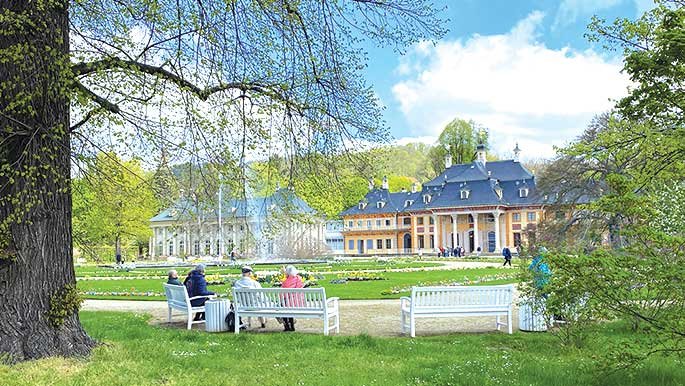Discover Dresden: A Storied City
/One of Dresden’s most beautiful churches is the Frauenkirche.
Peter and I are standing in The Transparent Factory in Dresden, Germany, watching humans and robots take turns assembling Volkswagen’s newest model: the ID.3, an electric car which “customers can drive off into the future,” says our friendly, knowledgeable guide, George, who’s from Greece. He’s giving us a tour, and around every corner we are awed by the efficiency and cleanliness of the factory. Assembly line employees even wear white!
The state-of-the-art production facility is right next to downtown Dresden, a city in Germany’s east formerly under communist rule. Today it’s a vibrant forward-looking city, yet the shadows of the past still linger.
Dresden was one of the most heavily bombed cities in WWII. Allied bombs exploded across the city, destroying its palaces and monuments. Today it has been almost completely restored. In fact, tourists are flocking to its streets to see the grand palace, cathedrals, and museums. There’s also plenty of kid-friendly activities for families who want to visit. Join Peter and me as we discover more about the past and present of this storied city.
Take a Tour at Volkswagen’s Transparent Factory
Learn about the Human Adventure at the German Hygiene Museum
Don’t miss a tour of The Transparent Factory where you’ll learn about next-gen Volkswagens.
I’m a VW fan, always have been. When George reels off their signature cars, my past flashes before my eyes. The two-tone VW van our family had when I was in elementary school, the beige VW bug that my brother gave me my senior year of high school, and the red Karmann Ghia I drove in college. Finally, the red bug I owned when I began my teaching career. That car ran like a sewing machine.
I’ve switched brands now, but I still look wistfully at Volkswagens that pass by. Maybe one day, I say. The new ID.3 would be top on my list, but availability in the U.S. will be limited—at least for the immediate future. The company plans to be all-electric by 2050, an initiative called “the way to zero (emissions),” explains George. “We are focused on the future of electro-mobility.”
The Transparent Factory is architecturally stunning with lots of glass (hence its name), solar power, and water features to keep the building cool. Trees surround the building, and recorded birdsong prevents feathered friends from flying into the glass. You can buy honey from the factory’s beehives in e-Vitrium, a gourmet restaurant nestled in the showroom area serving fresh cuisine.
Another museum we visit is called the German Hygiene Museum. The odd name doesn’t refer to keeping oneself clean, as you might think. It’s really a museum about humanity and the human body or, as their tag line says, the “human adventure,” and it’s packed with interesting exhibits—from aging to sexuality, drugs to beauty products. There’s also a children’s area with kid-friendly exhibits including experiments and games related to the five senses.
Our visit coincides with a German high school field trip, and the students are surprisingly captivated by the exhibits. A group of girls views a short film of a live birth, mesmerized, and another group watches two students play a video game designed to show how your reactions are impaired when you’re under the influence of drugs or alcohol. One interesting takeaway is that in 1850, Germany had 2000 apple varieties, and today there are only 600. As an apple fan, I’m hoping they don’t lose any more species because German apples are amazing.
Opulence is in store at the Dresden Royal Palace, which served as the residence of Saxon rulers from 1485 until the 1900s, including Augustus the Strong, who reigned over Saxony and Poland in the 17th century. It’s also home to fabulous art treasures, many of which are housed in the Green Vault, whose collection is divided in two parts. The historic rooms require a timed entry ticket—unfortunately sold out on the day we visit. No problem. Plenty of opulent décor, glamorous costumes, and ornate objects fill the rooms of the palace.
My favorite exhibit, the Turkish Chamber, includes artifacts from the Turkish War won by Augustus the Strong in 1697. Today it’s one of the most important collections of Ottoman art outside Turkey. There’s even a three-masted tent 45 feet long made of gold and silk, an amazing example of Ottoman craftsmanship. The rebuilt palace itself is also a stunning testament to German craftsmanship since it was it was reduced to rubble after the bombing in 1945.
See the Oldest Camellia at Castle Pillnitz
Visit Bastei Rock Formations in Swiss Saxony
Castle Pillnitz is among many castles in the region that date back centuries. Take time to stroll through the beautiful gardens.
Our spring visit is hampered by drizzly, cool weather—perfect for exploring museums as well as taking refuge in a Bavarian restaurant. Peter and I find one near the Frauenkirche (Church of Our Lady) called appropriately Augustiner an der Frauenkirche. No oom-pah bands here, but the décor is gorgeous: vaulted ceilings and lots of rustic wood. Ok, it’s a bit touristy—the servers wear dirndls and lederhosen—but the beer is delicious as is the potato soup, pretzel, and divine pancake we share.
Thankfully, the weather improves, and we’re excited about visiting local attractions. It’s hard to choose what to do: take a steamship cruise on the Elbe River, ride a steam-powered train in the bucolic countryside, visit a winery, or cycle along the river? Plus there are amazing castles in the region, including a royal pleasure palace called Moritzburg, once a hunting lodge but transformed into a picturesque moated castle by Augustus the Strong.
We opt for one a bit closer called Castle Pillnitz surrounded by acres of beautiful gardens, featuring tall hedges, trails, an ancient camellia tree, and a palm house. The castle, which dates to the 14th century, was originally a chateau until Augustus the Strong converted it into a summer palace for riverside festivities. It was used until the 1900s and has been left in its original condition, including a worn herringbone parquet floor in the ballroom where four tourists perform a spontaneous folk dance while Peter and I watch. In the kitchen you can almost smell the roasted lamb chefs likely cooked in the large fireplaces. A round chopping block looks well worn, and I think of the many guileless chickens that lost their heads there.
The palace grounds aren’t busy when we arrive, but now locals and tourists are everywhere, enjoying the beautiful day. We find the 250-year-old camellia tree, though it’s hidden inside a climate-controlled building. After a trek through the palm house, we stroll among the gardens, happy that the sun is shining.
One day we head to the mountains, to an area called Swiss Saxony. This little corner of Germany is known for its national park with beautiful scenery and hiking, as well as its picturesque villages. Many come to see the towering rocks called Bastei, part of the Elbe Sandstone Mountains, where overlooks offer birds-eye river views and you can walk across a 250-foot bridge stretching between the chimney-like rock formations. We visit on a weekend, and the Bastei is crawling with tourists. Since the pandemic ended, it seems everyone crowds into dramatic settings so they can take the perfect selfie and post it on Instagram. Time to seek out less popular sites.
While in Dresden one afternoon, we enjoy the quintessential European experience—two actually. The first is the local market, where we stroll, people watch, and learn about local food. White asparagus is everywhere, and we grab some to eat for dinner. I also try a currywurst with mustard on a chewy bun—so good—and find a lovely tablecloth with a lemon motif for our camper. Next we stumble upon a nearby beer garden, where we order drinks, sit under an awning, listen to the birds sing, and watch the rain fall. Sometimes it’s the simple things that we love best when we travel.
Plan Your Dresden Vacation
Tips To Design Your Visit to The Storied City
Swiss Saxony is a picturesque corner of Germany known for its beautiful scenery, hiking, and charming villages.
Take advantage of Dresden’s efficient public transportation.
Peter and I stayed in a campground in a neighboring city called Pirna. The tourism folks provided a Dresden Regio Card that allowed us unlimited use of trains, buses, and trams throughout the region. The Dresden Regio Card also includes discounts at museums, restaurants, and more. Cards cost approx. around 25-35 euros per day.
Use the Dresden Sightseeing Tour Hop On-Hop Off Bus.
The bus stops at 22 attractions and is a great way to get a feel for the city. It’s a bargain, especially if you get a 2-day pass for 22 euros. Even better, kids are free.
Get the Dresden Museum Card and save lots of euros while visiting the city’s many museums.
Besides the ones mentioned in the article, we recommend the Albertinum, a contemporary art museum; Porcelain Collection at the Zwinger; and the Saxon Folk Art Museum. Kids will love the Transportation Museum. Unfortunately, the Museums Card doesn’t grant entry to that or to the German Hygiene Museum. Luckily, admission fees are very reasonable.
Stop by the tourist bureau.
Pick up the brochure called Dresden with Children, where you’ll find lots of good ideas for attractions the whole family will enjoy.
Visit the Dresden Tourism website.
You’ll find for up-to-date information on upcoming events, museum exhibits, restaurants, shopping, and more.
Tour the Transparent Factory.
For more information about a tour of the Transparent Factory and a test drive of the new ID.3, please visit www.glaesernemanufaktur.de/en.html.
Read the Story of Dresden.
For a compelling pre-visit read, check your library for a copy of Kurt Vonnegut’s Slaughterhouse Five. Vonnegut was a WWII prisoner of war and tells of the apocalyptic firebombing of Dresden like no other storyteller can. Another good account of the Dresden bombing can be found on the website of the World War II Museum in New Orleans. Visit www.nationalww2museum.org and search for Dresden.
Editor’s Note: Peter and Peggy are camping in Europe currently and invite you to follow their adventures on Tidewater Family Plus’ Facebook page. Ciao for now!
















